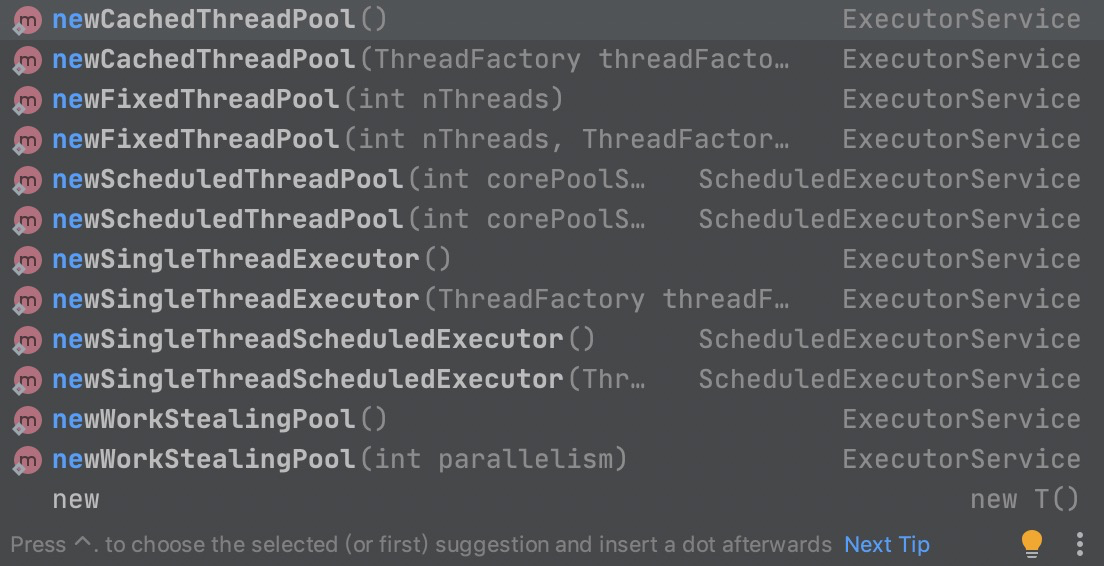线程池在开发中一定会用到,如果能像golang一样,java语言也有协程,也许java程序员就少了一种包袱。
回归正题,我们聊下到底有哪些线程池的使用方式,总结有以下几种。
- JDK 内置线程池
- Spring线程池
- 自己魔改封装
1、JDK 内置线程池
常用的有:
我们看下最全的线程池参数,探究为什么阿里规约不建议使用Executors创建默认个数的线程池。
/**参数【7个】corePoolSize - 即使空闲时仍保留在池中的线程数,除非设置 allowCoreThreadTimeOutmaximumPoolSize - 池中允许的最大线程数keepAliveTime - 当线程数大于内核时,这是多余的空闲线程在终止前等待新任务的最大时间。unit - keepAliveTime参数的时间单位workQueue - 用于在执行任务之前使用的队列。 这个队列将仅保存execute方法提交的Runnable任务。threadFactory - 执行程序创建新线程时使用的工厂handler - 执行被阻止时使用的处理程序,因为达到线程限制和队列容量四个预定义的处理程序策略在默认ThreadPoolExecutor.AbortPolicy ,处理程序会引发运行RejectedExecutionException后排斥反应。在ThreadPoolExecutor.CallerRunsPolicy中,调用execute本身的线程运行任务。 这提供了一个简单的反馈控制机制,将降低新任务提交的速度。在ThreadPoolExecutor.DiscardPolicy中 ,简单地删除无法执行的任务。在ThreadPoolExecutor.DiscardOldestPolicy中 ,如果执行程序没有关闭,则工作队列头部的任务被删除,然后重试执行(可能会再次失败,导致重复)。**/public ThreadPoolExecutor(int corePoolSize, int maximumPoolSize, long keepAliveTime, TimeUnit unit, BlockingQueue<Runnable> workQueue, ThreadFactory threadFactory, RejectedExecutionHandler handler) { if (corePoolSize < 0 || maximumPoolSize <= 0 || maximumPoolSize < corePoolSize || keepAliveTime < 0) throw new IllegalArgumentException(); if (workQueue == null || threadFactory == null || handler == null) throw new NullPointerException(); this.acc = System.getSecurityManager() == null ? null : AccessController.getContext(); this.corePoolSize = corePoolSize; this.maximumPoolSize = maximumPoolSize; this.workQueue = workQueue; this.keepAliveTime = unit.toNanos(keepAliveTime); this.threadFactory = threadFactory; this.handler = handler; }1.1 阿里规约原文
线程池不允许使用Executors去创建,而是通过ThreadPoolExecutor的方式,这样的处理方式让写的同学更加明确线程池的运行规则,规避资源耗尽的风险。
说明:Executors返回的线程池对象的弊端如下:
1)FixedThreadPool和SingleThreadPool:
允许的请求队列长度为Integer.MAX_VALUE,可能会堆积大量的请求,从而导致OOM。
2)CachedThreadPool:
允许的创建线程数量为Integer.MAX_VALUE,可能会创建大量的线程,从而导致OOM。
1.2 阿里规约是否是多余的?不然jdk为啥提供这个api?
答案可以看下ThreadPoolExecutor类的上的注释,已翻译成中文:
为了在广泛的上下文中有用,此类提供了许多可调参数和可扩展性钩子。 然而,程序员被敦促使用更方便的Executors工厂方法Executors.newCachedThreadPool() (无限线程池,具有自动线程回收), Executors.newFixedThreadPool(int) (固定大小的线程池)和Executors.newSingleThreadExecutor() (单个后台线程),可以预先配置最常用的使用场景设置。 否则,手动配置和调优此类时,请使用以下指南...其实这个类的作者"Doug Lea",已经说明Executors.newCachedThreadPool(),Executors.newFixedThreadPool(int),应该是在什么情况下使用?
只是一般程序员是不会去仔细看类说明文档,都是跟着百度复制过来的代码就干起活来了,
说起来也惭愧之前在2010年培训的时候,其实是会看这个jdk api文档的,但那个时候似乎很懵,也不会去详尽的看文档背后的一些知识点。
所以说看第一手材料多么重要,作者已经把该注意的点都写到类说明文档注释里了,吓得我赶紧用到一个类都去细看下文档注释,解决不了再找度娘。
1.3 线程池不为人知的几个冷门知识点
从几个面试题来一一道来。
1.核心和最大线程池是否都可以动态修改?
可以使用setCorePoolSize(int)和setMaximumPoolSize(int)进行动态 更改
2.核心线程最初创建并且只有在新任务到达时才启动?
可以使用方法prestartCoreThread()或prestartAllCoreThreads()动态地覆盖。如果您使用非空队列构建池,则可能需要预先提供线程。
3.核心线程是否一定不终止?
不一定,报错或者allowCoreThreadTimeOut(boolean)也可以用于将这个超时策略应用于核心线程,只要keepAliveTime值不为零
4.如何给线程池添加一个启动/暂停的功能?
class PausableThreadPoolExecutor extends ThreadPoolExecutor { private boolean isPaused; private ReentrantLock pauseLock = new ReentrantLock(); private Condition unpaused = pauseLock.newCondition(); public PausableThreadPoolExecutor(...) { super(...); } protected void beforeExecute(Thread t, Runnable r) { super.beforeExecute(t, r); pauseLock.lock(); try { while (isPaused) unpaused.await(); } catch (InterruptedException ie) { t.interrupt(); } finally { pauseLock.unlock(); } } public void pause() { pauseLock.lock(); try { isPaused = true; } finally { pauseLock.unlock(); } } public void resume() { pauseLock.lock(); try { isPaused = false; unpaused.signalAll(); } finally { pauseLock.unlock(); } } }} 2、Spring线程池
官方已经实现的全部7个TaskExecuter。Spring宣称对于任何场景,这些TaskExecuter完全够用了:
| 名字 | 特点 |
|---|---|
| SimpleAsyncTaskExecutor | 每次请求新开线程,没有最大线程数设置.不是真的线程池,这个类不重用线程,每次调用都会创建一个新的线程。限流是通过 ConcurrencyThrottleSupport类的monitor的wait(),notify() 实现的 |
| SyncTaskExecutor | 不是异步的线程.同步可以用SyncTaskExecutor,但这个可以说不算一个线程池,因为还在原线程执行。这个类没有实现异步调用,只是一个同步操作。 |
| ConcurrentTaskExecutor | Executor的适配类,不推荐使用。如果ThreadPoolTaskExecutor不满足要求时,才用考虑使用这个类。 |
| SimpleThreadPoolTaskExecutor | 监听Spring's lifecycle callbacks,并且可以和Quartz的Component兼容.是Quartz的SimpleThreadPool的类。线程池同时被quartz和非quartz使用,才需要使用此类。 |
| ThreadPoolTaskExecutor | 最常用。要求jdk版本大于等于5。可以在程序而不是 |
| TimerTaskExecutor | |
| WorkManagerTaskExecutor |
- 使用ThreadPoolExecutorFactoryBean
package org.springframework.scheduling.concurrent;public class ThreadPoolExecutorFactoryBean extends ExecutorConfigurationSupport implements FactoryBean<ExecutorService>, InitializingBean, DisposableBean { private int corePoolSize = 1; private int maxPoolSize = 2147483647; private int keepAliveSeconds = 60; private boolean allowCoreThreadTimeOut = false; private int queueCapacity = 2147483647; private boolean exposeUnconfigurableExecutor = false; @Nullable private ExecutorService exposedExecutor; public ThreadPoolExecutorFactoryBean() { } ... protected ThreadPoolExecutor createExecutor(int corePoolSize, int maxPoolSize, int keepAliveSeconds, BlockingQueue<Runnable> queue, ThreadFactory threadFactory, RejectedExecutionHandler rejectedExecutionHandler) { return new ThreadPoolExecutor(corePoolSize, maxPoolSize, (long)keepAliveSeconds, TimeUnit.SECONDS, queue, threadFactory, rejectedExecutionHandler); }- 使用ScheduledExecutorFactoryBean
package org.springframework.scheduling.concurrent;public class ScheduledExecutorFactoryBean extends ExecutorConfigurationSupport implements FactoryBean<ScheduledExecutorService> { private int poolSize = 1; @Nullable private ScheduledExecutorTask[] scheduledExecutorTasks; private boolean removeOnCancelPolicy = false; private boolean continueScheduledExecutionAfterException = false; private boolean exposeUnconfigurableExecutor = false; @Nullable private ScheduledExecutorService exposedExecutor; public ScheduledExecutorFactoryBean() { }使用ThreadPoolTaskExecutor
这个类可以设置回调方法使用ThreadPoolTaskScheduler
这个类可以设置回调方法,包装错误处理类,错误不会影响执行下一个任务@Scheduled就是使用这个类包装的,注意核心默认一个线程,会阻塞任务
@Override public void run() { try { this.delegate.run(); } catch (UndeclaredThrowableException ex) { this.errorHandler.handleError(ex.getUndeclaredThrowable()); } catch (Throwable ex) { this.errorHandler.handleError(ex); } }参考
[java8 api] https://www.matools.com/api/java8
[spring线程池(同步、异步)] https://www.cnblogs.com/duanxz/p/9435343.html
扫描二维码,关注公众号"猿必过"

回复 "面试题" 自行领取吧。
微信群交流讨论,请添加微信号:zyhui98,备注:面试题加群
本文由猿必过 YBG 发布
禁止未经授权转载,违者依法追究相关法律责任
如需授权可联系:zhuyunhui@yuanbiguo.com
原文转载:http://www.shaoqun.com/a/603576.html
c88是什么:https://www.ikjzd.com/w/1017
西农:https://www.ikjzd.com/w/1368
线程池在开发中一定会用到,如果能像golang一样,java语言也有协程,也许java程序员就少了一种包袱。回归正题,我们聊下到底有哪些线程池的使用方式,总结有以下几种。JDK内置线程池Spring线程池自己魔改封装1、JDK内置线程池常用的有:我们看下最全的线程池参数,探究为什么阿里规约不建议使用Executors创建默认个数的线程池。/**参数【7个】corePoolSize-即使空闲时仍保留
catch:https://www.ikjzd.com/w/832
shopyy:https://www.ikjzd.com/w/1661
imgur:https://www.ikjzd.com/w/156
口述:"算计"得来英俊男友(2/2):http://lady.shaoqun.com/m/a/83969.html
你还在发自嗨式的开发信吗?:https://www.ikjzd.com/home/132126
亚马逊中国成为被执行人 执行标的23420:https://www.ikjzd.com/home/132140
No comments:
Post a Comment